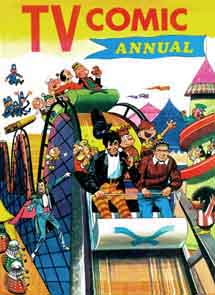The 1968 TV Comic Annual

|
|
TV Publications Ltd The 1968 TV Comic Annual |

|
| Published | 1967 |  |
| Starring the second Doctor, John and Gillian |
A Review by Finn Clark 4/7/04
If you've read the last two TV Comic annuals, pretty much what you'd expect. Popeye has a new artist and Tivvy can now talk, but otherwise it's business as usual. Mighty Moth's still amiable but bland, though I was surprised to learn for the first time that he has superhuman strength. (A moth who can throw a man!) For the first time Beetle Bailey has an crap "ho ho" punchline to one of his stories, but he's still a class act and the best of these funnies. I particularly enjoyed the story about Sergeant Ovie Snorkel being busted down to Private 3rd Class, while p39 convinced me that Ovie's insane.
Tivvy's still pointless, though his Happy Friends Holiday Camp story on pp20-21 would have been fantastic as the lead-in to a longer tale. Unfortunately as it stands it's all set-up with no payoff.
The TV Terrors' relationship with Hoppit grows ever-stranger. In a few years he'll be inviting them home to hear his music (dodgy or what?) while here he gets another job but the Terrors get him sacked to get him back on their TV studio door. Presumably they like being booted them up the arse. Hoppit is increasingly deranged; I loved the story where he goes on holiday and starts guarding random doors on the cruise liner to remind him of work. (We also glimpse the Terrors' rarely-seen dog, Spot.)
There are new strips, the most important being the new cover stars: Ken Dodd's Diddymen. Should we rename Dodd's Season 24 story as Delta and the Diddymen? (His photo here looks so young that it'll blow your mind.) This year's Diddymen stories are mostly bollocks, but in future years they mutated into Goon-a-like weirdness. Even in this relatively sane debut they manage to burn down an entire office block while trying to deal with business memos.
Bob Monkhouse's Mad Movies were hopefully not written by the late Mr Monkhouse (died 29 December 2003) and instead just copied his TV show of that name. They star the Keystone Kops and are rancid garbage. Since Monkhouse was a comedy writer and one-time animator at Disney's London studios, I hope he'd have been able to do a better job than this!
There's an adventure strip called Orlando, based on the children's TV series about Orlando O'Connor (played by Sam Kidd), a hard man with a detective agency and two teenage chums (played by David Munro and Judy Robinson). These Orlando stories are pretty hard-boiled by TV Comic standards, outshining their rivals in this book: Adam Adamant and The Three Musketeers.
Things I learned from reading this book:
In Attack of the Daleks, the Doctor tests his flying bicycle (the "pedal-copter") and gets attacked by the world's silliest Daleks. You'd think Patrick Williams was painting with his feet, but even that wouldn't explain these startling creations. Imagine a phallic object that comes in green, blue, gold, red or pastel pink. It has a drinking straw instead of a gun, but its eye stick is two feet long and possibly an offensive weapon in itself. Its one and only head light is on the left hand side, in a jam jar housing even bigger than in the Cushing movies.
Oh, and their death screams suggest that they're Farmer Daleks from the West Country. "A-A-R." This is why we all love TV Comic.
Pursued by the Trods is almost as big a laugh, giving us a 2nd Doctor whose recorder can control mammoths in the year 500,000 BC. (The year is on the TARDIS's year meter.) The Trods were TV Comic's "no no we're not ripping off the Daleks, honest" monsters, appearing in three previous stories as a bunch of cone-shaped robots on the planet Trodos. Fun, but not intimidating. However here when pursued by a time machine, the Doctor says: "I can think of only one power with the brains and resources to create such a machine... the Trods!" Huh? Since when?
Also... "the Trods run off static electricity. If I can wreck the plant they'll all be immobilised!" No, obviously they're not cheapoid Dalek clones! Whatever gave you that idea?
I don't want to give the impression that pre-Marvel Doctor Who strips were merely a farrago of "so bad they're good" stories and childish art. On the contrary, TV Comic's artists were often streets ahead of what we get today. Their fully painted stuff could be beautiful - and even here Patrick Williams manages a few top-notch Troughton likenesses. It's characterful stuff. Similarly the scripting may not always be intellectual (ahem) but these stories are fun, colourful and lively. I wouldn't part with my copies for the world.